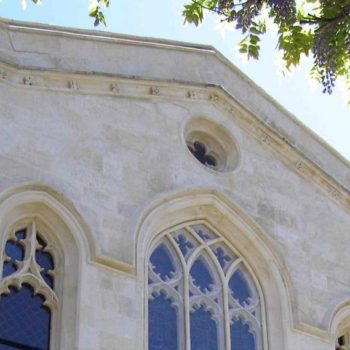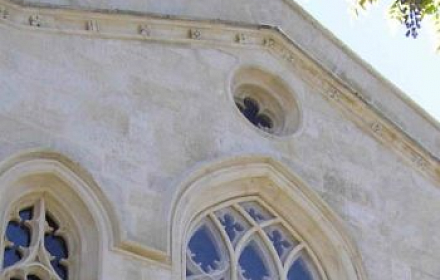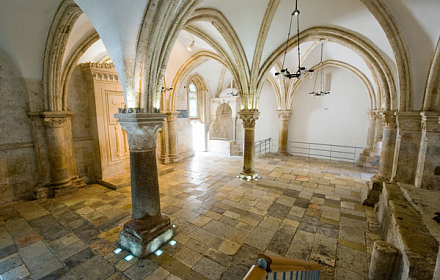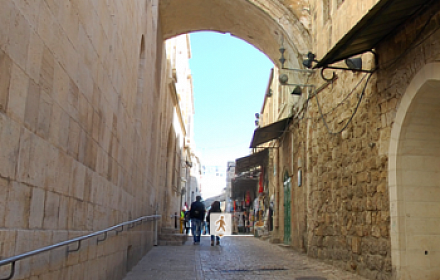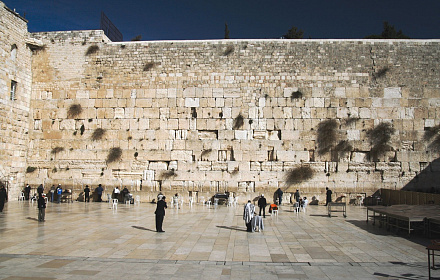About Virtual Tour
Entrance
Not far form Jaffa Gate and opposite King David’s citadel stands a Protestant Church with an architectural style distinguished from the neighboring buildings of the Old City. This is an Anglican Christ Church. When judged by Jerusalem’s standards, one can call it a fairly recent construction – it was built in the middle of the 19th century – and has been associated with interesting events of local and world history. Let's go on a virtual pilgrimage.
In the beginning of the nineteenth century the London Jews’ Society was established in England. Its mission was to promote Christianity amongst the Jews. Many missionaries were sent to Jerusalem. John Nicholson was probably the major figure among them. Due largely to his efforts, in 1833 the first Protestant representative office opened in Palestine. The construction of an Anglican church was made possible only after the British consulate opened in Jerusalem: Ottoman authorities imposed a condition that the new Christian church has to be located exclusively in the territory of the diplomatic mission. The construction works were conducted by the London Jews’ Society simultaneously with building a British consulate. The Great Britain aimed at promoting “the Reformation’s pure Christianity”, and invited English architects and stonemasons from Malta to work upon this project. However, Orthodox countries represented by Russia, and Catholic countries represented by Austria and France tried as much as they could to prevent the spread of Protestantism in Palestine. Ottoman authorities also intervened and suspended the construction and its resumption has to be negotiated by British diplomats. The only Great Britain’s ally in this matter was Prussia. Despite considerable opposition, the construction of the Christ Church in the New Gothic style was successfully completed and the consecration was held in 1849. The Anglican bishop’s throne was already present in the Holy Land at the time, and Protestant liturgy in English and in Hebrew was held inside a temporary construction. By the time its consecration day finally came, the church already had a small but regular congregation…
We’ll go inside the well-preserved sesquicentennial church building to examine its interior, where Christianity and Judaism, Old and New Testaments are rather oddly intertwined.
Church
Its appearance, which is rather unusual for the Old Jerusalem, becomes somewhat strange for a Christian house of worship. It is understandable that we don’t see any icons or statues for this is a Protestant church, but this is probably the only place where you can see scripts from the New Testament in Hebrew. There are also many Jewish symbols: menorah, Star of David, and a cabinet that looks like aron ha-qodesh, which can be seen in every Jewish synagogue. Though the abundance of Old Testament symbols won’t seem so strange if we recall the fact that it was built for a Jewish congregation. Its main goal was to bring Protestant Christians and Jews together — the purpose shared by the founders of the London Jews’ Society and later by the whole Episcopal Church in Jerusalem and the Middle East. The second Anglican bishop of Jerusalem started mission activity among the local Christian Arabs, predominantly practicing Orthodox faith.While most of the stonework for the Christ Church was done by the Maltese masters, stained-glass windows and woodworking were designed and made in the traditional English style. Wood materials were shipped from Great Britain to Jaffa, and ultimately transported by camels to Jerusalem.
Interestingly, the Protestant episcopate of Jerusalem remained English-Prussian for quite a long time – until 1886, and only at the time of the fourth bishop it became Anglican. In 1899 the seat of the Anglican Bishop in Jerusalem was transferred into the newly built St. George’s Cathedral. The Christ Church remained under the authority of the London Jews’ Society, which was reformed and changed its name, but still focused on its main mission: promoting Christianity among the Jews. It must be said that the organization had rather modest success in the Holy Land: not so many Jews were ready to abandon the faith of their ancestors and convert to Protestantism. However, by the end of the 19th – early 20th century it was a powerful missionary society with branch offices in Russia, Romania, Austria, Ottoman Empire, and many other countries. As for Jerusalem, besides the Christ Church, the society built a hospital and some other constructions. Apart from missionary work, teaching and medical sciences, it was also involved in agricultural projects. In 1995 it once again changed its name to The Church's Ministry Among Jewish People.
Altar
Today the Christ Church has the status of a founding church and is part of Jerusalem diocese. It has a second name — Immanuel Church. It’s a messianic church that is supports the state of Israel and stays committed to the idea of the return of Jews to the Holy Land. This policy conflicts with the position of diocese, which removed the word “Israel” within the church use and denies in principle the role of Jews as God’s chosen people.
The difference in views between the two religious communities is acceptable for the Anglican Church, whose followers are confined to the 39 dogmas of faith and must venerate the Holy Scripture — at the same time they are free to have different interpretations of it and have their own view on any given issue.
Today there is a hostel operated by the Christ Church that provides inexpensive lodging for pilgrims and tourists visiting the Holy Land. There is also a soup kitchen that offers common non-kosher food. You may access the church premises under condition that you will hear a brief lecture about its past history and present-day activities. You should also familiarize yourself with the applicable safety regulations when descending into the crypt.
The crypt is worth mentioning: during the construction of the Christ Church, parts of an ancient water conveyance system were discovered. It connected the Temple Mount with the palace of king Herod. Today visitors can see water tanks, water conduits and other traces of the Old City’s ancient history. To get into the crypt, you must go down the narrow staircase leading from the museum’s entrance lobby. A 19-th century carved wooden replica of the Second Temple welcomes visitors at the entry. Apart from this, the local museum has many other notable exhibits.
The doors of the Christ Church are open to the general public every day, seven days a week, from eight in the morning to eight at night local time. The divine service is held in English on Sundays twice a day. The convenient location of the church near the main tourist gateway of the Old City — Jaffa Gate — makes it a very attractive place. The building’s European outlines and elongated Gothic style windows – so unusual for the ancient Jerusalem – form a particular appeal for visitors from all over the world.
Send donation
If you are in a difficult financial situation, we will light the candle for free. For that purpose email us at coordinator@santosepulcro.co.il
Payment Methods
